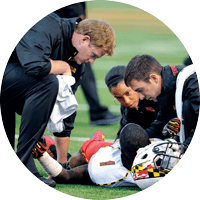- October 05, 2016
- By Maryland Today Staff
From the playing fields of the Big Ten to the battlefields of Iraq and Afghanistan, traumatic brain injury (TBI) has become a pressing medical issue. Yet those at risk aren’t just athletes strapping on football helmets or soldiers climbing into Humvees—they are drivers navigating the highways, children turning cartwheels in the yard and the elderly navigating tricky stairs.
 In 2010 alone, more than 2.5 million emergency room visits, hospitalizations and deaths were associated with TBI, according to the Centers for Disease Control and Prevention. And as awareness and reporting of these injuries rise, so do questions for researchers.
In 2010 alone, more than 2.5 million emergency room visits, hospitalizations and deaths were associated with TBI, according to the Centers for Disease Control and Prevention. And as awareness and reporting of these injuries rise, so do questions for researchers.
“What factors control the different recovery rates for TBI?” asks University of Maryland, College Park biology Professor Elizabeth Quinlan. “What can be done to promote recovery and response?”
The Center for Sports Medicine, Health and Human Performance in the new Cole Field House at UMD will be at the forefront of tackling this public health problem and advancing the science of sport in a partnership with the University of Maryland, Baltimore (UMB).
The center, co-directed by Quinlan and Dr. Alan Faden, the David S. Brown Professor in Trauma at the University of Maryland School of Medicine (SOM), will bring together the scientific expertise of UMD with the clinical faculties of SOM in Baltimore. It is the latest collaboration between UMD and UMB through the MPowering the State initiative, which is designed to leverage the strengths of the two institutions.
“The breadth and scope of this center is well beyond what currently exists in other sports performance centers,” Faden says. “It is intended to harness unique and complementary capabilities across the two campuses.”
 The new Cole, expected to be completed in 2019, is bringing academics and entrepreneurship, football operations and athletic training together under one roof. It will have more than 40,000 square feet of research and clinical space for experts in neuroimaging, genomics and biomechanics, and an orthopedics clinic will take advances from the lab to the broader community.
The new Cole, expected to be completed in 2019, is bringing academics and entrepreneurship, football operations and athletic training together under one roof. It will have more than 40,000 square feet of research and clinical space for experts in neuroimaging, genomics and biomechanics, and an orthopedics clinic will take advances from the lab to the broader community.
Kevin Plank ’96, founder and CEO of Under Armour, pledged $25 million to launch the project and has called Cole an opportunity to “define a new era for Maryland.”
The driving focus of that new era will be to address one of the most important medical issues of modern life.
“A significant percentage of the population will suffer a head injury,” Faden says. “The number of individuals affected is considerably larger than previously recognized.”
These injuries can cause depression, sleep disorders and cognitive decline and adversely impact a victim’s ability to function. Already, $3 million has been invested to fund cross-university, multi-disciplinary studies in brain and behavior, and injury, recovery and enhancement.
Even though adult brains are much less “plastic” than those of children, research shows how to reactivate some flexibility. For example, exercise, intermittent fasting and cognitive training have the capability to limit the consequences of brain injury and to facilitate recovery.
 “Each of these potential therapies may tap into the same mechanisms to promote plasticity,” Quinlan says. “When is the most important time to learn? When you are stressed, when you are challenged, when you are in ‘fight or flight’ mode.”
“Each of these potential therapies may tap into the same mechanisms to promote plasticity,” Quinlan says. “When is the most important time to learn? When you are stressed, when you are challenged, when you are in ‘fight or flight’ mode.”
Researchers at Cole, with its community of coaches, athletes, scientists and clinicians, will explore the details of these processes by creating enhanced diagnostic tools and using “big data” computing capabilities to map the brain’s litany of metabolic pathways and neuronal connections.
“We are going to utilize a wide array of advanced research tools to study the mechanisms that lead to cell death or cell dysfunction after brain injury, with the goal of improving recovery and limiting disability,” Faden says.
That is Cole’s starting point. But the true benefit, Quinlan says, is opening a door into a fuller understanding of the human brain.
“The collection of experts from diverse fields will allow us to approach problems in an exciting and highly interdisciplinary way,” she says.
Tags
Research